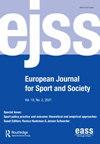POSTURE CORRECTION FOR HIGH SCHOOL STUDENTS USING MANUAL TECHNIQUES
IF 1
Q2 HOSPITALITY, LEISURE, SPORT & TOURISM
引用次数: 0
Abstract
A high prevalence of postural deviations is confirmed by the literature and considering the risk factors that can manifest in adolescents, an efficient method of intervention, that can be used on every type of patient, is important to be available to the therapist, taking into account the lack of a pro-active behaviour dominant in today society. The purpose of this study is to check if the therapeutic intervention carried out through manual techniques can improve the body alignment at the level of the spine. The subjects of this study were 20 14 to 16 years old high school students, from which 8 females and 12 males. Materials and method: The participants were evaluate using the KINEOD posturograph that utilizes infrared acquisition technology to provide a complete 3D postural analysis. An intervention program based on osteopathic manual technics, made by 10 sessions, was applied over a course of 3 months, and then the participants were reevaluated. The data received from the software of the KINEOD posturograph was analyzed and interpreted statistically, and the results were presented as tables and graphs. Conclusions: Results indicate that the intervention program used generated a numerical positive outcome in all four parameters evaluated, and in 2 of them the difference is statistically significative (“Shoulder imbalance” – P=0.007, “C7 deviation - Barré Vertical” – P= 0.049). From this we can conclude that manual technics can be used successfully in correction of the posture at spinal level.高中生姿势矫正的手工技巧
文献证实了体位偏差的高患病率,考虑到青少年中可能出现的风险因素,考虑到当今社会缺乏主导性的主动行为,治疗师可以使用一种有效的干预方法,这种方法可以用于每种类型的患者,这一点很重要。本研究的目的是检查通过手工技术进行的治疗干预是否可以改善脊柱水平的身体对齐。本研究以2014 ~ 16岁高中生20名为研究对象,其中女生8名,男生12名。材料和方法:使用KINEOD体位仪对参与者进行评估,该体位仪利用红外采集技术提供完整的3D体位分析。一项基于整骨疗法手工技术的干预计划,由10个疗程组成,为期3个月,然后对参与者进行重新评估。对KINEOD体位仪软件接收到的数据进行统计分析和解释,结果以表格和图表的形式呈现。结论:结果表明,所采用的干预方案在评估的所有四个参数中均产生了数值阳性结果,其中2个参数的差异具有统计学意义(“肩部不平衡”- P=0.007,“C7偏差- barr垂直”- P= 0.049)。由此我们可以得出结论,手工技术可以成功地用于脊柱水平的姿势矫正。
本文章由计算机程序翻译,如有差异,请以英文原文为准。
求助全文
约1分钟内获得全文
求助全文
来源期刊

European Journal for Sport and Society
HOSPITALITY, LEISURE, SPORT & TOURISM-
CiteScore
3.30
自引率
4.20%
发文量
17
 求助内容:
求助内容: 应助结果提醒方式:
应助结果提醒方式:


